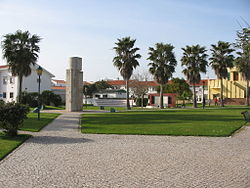Vila do Bispo
| Vila do Bispo | |||
|---|---|---|---|
| Municipality | |||

The main square of Vila do Bispo
|
|||
|
|||
 |
|||
| Coordinates: 37°5′N 8°53′W / 37.083°N 8.883°WCoordinates: 37°5′N 8°53′W / 37.083°N 8.883°W | |||
| Country |
|
||
| Region | Algarve | ||
| Subregion | Algarve | ||
| Intermunic. comm. | Algarve | ||
| District | Faro | ||
| Parishes | 4 | ||
| Government | |||
| • President | Adelino Soares | ||
| Area | |||
| • Total | 179.06 km2 (69.14 sq mi) | ||
| Population (2011) | |||
| • Total | 5,258 | ||
| • Density | 29/km2 (76/sq mi) | ||
| Time zone | WET/WEST (UTC+0/+1) | ||
| Postal code | 8650 | ||
| Area code | 282 | ||
| Website | www |
||
Vila do Bispo (Portuguese pronunciation: [ˈvila ðu ˈβiʃpu]) is a municipality (concelho) in the Portuguese Algarve. The population in 2011 was 5,258, in an area of 179.06 km².
The first references to this region referred to the Aldeia do Bispo in the 14th century, in a charter dated 27 March 1329, and later, in 1353, a royal charter that promulgated the addition of the "locality that is called Bispo, which is in the Cape of Saint Vincent...", into the bishopric and domain/jurisdiction of Silves Municipality. This version of the circumstances would be contradicted throughout history. Lopes Silva (1841) indicated that the village of Bispo, later Vila do Bispo, arrived from the donation of the Aldeia de Santa Maria do Cabo by King Manuel to Bishop Fernando Coutinho. There is an assumption that this settlement, donated in 1515, became known as the Town of the Bishop, but the reality refers to several letters in 1329 and 1353, suggesting that the Aldeia do Bispo existed in the 14th century. In fact, Aldeia de Santa Maria do Cabo and Aldeia do Bispo were two distinct localities.
Another centre in Vila do Bispo was the locality of Nossa Senhora da Graça, which was mentioned in a royal charter issued by King Ferdinand, was situated south of the hermitage of Guadalupe, in the locality of Alto da Senhora da Graça, where the archaeological station of Veiga found vestiges of an extinct settlement, of Muslim origin, that were posterior the medieval Christian settlement. Near this area are toponomic references to Zavial and the strategic Alto da Senhora da Graça, where, in Ponta da Torre there exists remnants identifying the regions importance. It is assumed that during the Reconquista (around 1248) this area was a difficult battleground for the Christians, who likely invoked the "Virgin" for protection during their bloody battles. After their victory the settlement began to be referred to as the Aldeia da Graça (or Nossa Senhora da Graça) for the grace the obtained in the conquest of these lands. It is likely that the settlement was depopulated following the outbreak of the Black Death (around 1348), even as two-thirds of the population was infected.
...
Wikipedia


